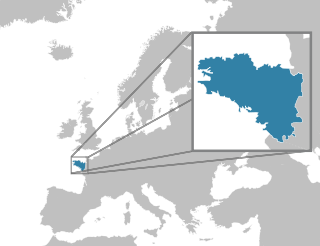
Brittany is a cultural region in the northwest of France, covering the western part of what was known as Armorica during the period of Roman occupation. It became an independent kingdom and then a duchy before being united with the Kingdom of France in 1532 as a province governed as if it were a separate nation under the crown.

André Breton was a French writer, poet, and anti-fascist. He is known best as the co-founder, leader, principal theorist and chief apologist of Surrealism. His writings include the first Surrealist Manifesto of 1924, in which he defined surrealism as "pure psychic automatism".

Finistère is a department of France in the extreme west of Brittany.
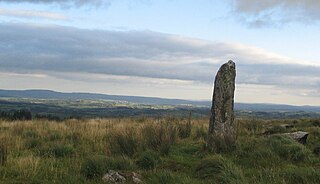
A menhir, standing stone, orthostat, or lith is a large man-made upright stone, typically dating from the European middle Bronze Age. They can be found solely as monoliths, or as part of a group of similar stones. Menhirs' size can vary considerably, but they are generally uneven and squared, often tapering towards the top.

A Breton lai, also known as a narrative lay or simply a lay, is a form of medieval French and English romance literature. Lais are short, rhymed tales of love and chivalry, often involving supernatural and fairy-world Celtic motifs. The word "lay" or "lai" is thought to be derived from the Old High German and/or Old Middle German leich, which means play, melody, or song, or as suggested by Jack Zipes in The Oxford Companion to Fairy Tales, the Irish word laid (song).

Gallo is a regional language of France. It is not as commonly spoken as it once was, as the standard form of French now predominates. Gallo is classified as one of the Oïl languages.
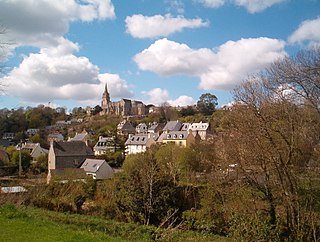
Lannion is a commune in the Côtes-d'Armor department in Brittany in northwestern France. It is a subprefecture of Côtes-d'Armor, the capital of Trégor and the center of an urban area of almost 60,000 inhabitants.
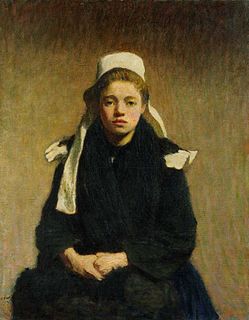
The Bretons are a Celtic ethnic group located in the region of Brittany in France. They trace much of their heritage to groups of Brittonic speakers who emigrated from southwestern Great Britain, particularly Cornwall and Devon, mostly during the Anglo-Saxon invasion of Britain. They migrated in waves from the 3rd to 9th century into Armorica, which was subsequently named Brittany after them.
Events from the year 1999 in France.

Le Saint is a commune in the Morbihan department of Brittany in north-western France.

Plérin is a coastal commune in the Côtes-d'Armor department of Brittany in northwestern France. The Marché du Porc Breton, located in Plérin, is where the price of pork is set for retailers across France.

The pointe de Pen-Hir is a promontory of the Crozon peninsula in Brittany, to the south-west of Camaret-sur-Mer. On a clear day there are views to the Pointe du Raz and the islands of Sein and Ouessant and to Pointe Saint-Mathieu. The cliffs can be as tall as 70 metres (230 ft) high.

Les Ramoneurs de menhirs is a Breton celtic punk group formed in 2006. Its members include Éric Gorce on the bombardon, Richard Bévillon on the bagpipes, the traditional vannetais singer Gwenaël Kere and Loran, guitarist from the group Bérurier Noir. They play concerts at fest noz as well as normal rock concerts. Most of their songs are sung in Breton.
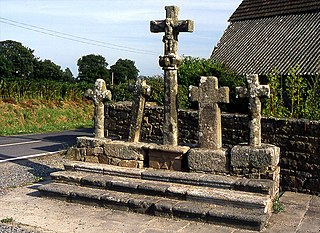
The Five Crosses are a set of stone crosses at Ploubezre, near Lannion, Côtes-du-Nord, in Brittany, France, classified as a historic monument by a decree of 7 December 1925 and, as a group, attributed to the 18th century.
Alain II Hir, "Alain II the tall", (c.630-690), also known as Alan Hir was a king of Brittany who succeeded his father Saint Judicael as ruler of Domnonée and high king of the Bretons. Little is known about his life. He is mentioned as the brother of saints Judoc and Winnoc, and as an ally of Cadwaladr (Cadwallader), the last King of the Britons.
This page is based on this
Wikipedia article Text is available under the
CC BY-SA 4.0 license; additional terms may apply.
Images, videos and audio are available under their respective licenses.














